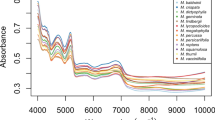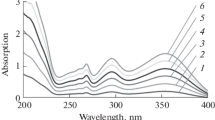Abstract
Yerba mate plants are part of the ombrophilous mixed forest with araucaria trees. Genetically improved yerba mate clones are classified into two groups of interest to a selective consumer public, decaffeinated and high caffeine plants. Quality control strategies for this type of food are essential, and multivariate tools can help in this procedure. Partial least squares-discriminant analysis (PLS-DA) was used to identify chemically differentiated yerba mate plants together with reflectance measurement (900–1700 nm) near-infrared spectroscopy (NIRS) in direct analysis of plant material. Yerba mate plants were cultivated in the semi-hydroponic system under five plant shading levels (0%, 40%, 51%, 76%, and 82%). Robustness of the mathematical model was verified for plants with all these shading levels. The PLS-DA model showed a sensitivity of 96.52% for the training set and 93.33% for the test set. Specificity greater than 97.12% was found for both sets, with an efficiency rate of 96.82% for the training set and 95.31% for the test set. Wilcoxon signed classification, sign classification in pairs, and randomization t-tests showed an excellent model fit. Principal component analysis of the NIR spectra demonstrated that shading affected the chemical composition more in high-caffeine clones than in decaffeinated ones. This indicates that the caffeine synthesis in yerba mate plants represents an adaptative strategy to elevated light conditions.
Graphical Abstract







Similar content being viewed by others
Data Availability
The datasets generated during and/or analyzed during the current study are available from the corresponding author on reasonable request.
References
BonfattiJúnior EA, Lengowski EC, LudkaJúnior A (2018) Mapeamento do processo produtivo de erva-mate. Rev Int de Cienc 8:82–98. https://doi.org/10.12957/ric.2018.32500
Brandt M, Silva NS (2014) A coleta da erva-mate pela população cabocla do vale do rio do peixe e oeste de santa catarina: apropriação privada da terra e rupturas (décadas de 1900 a 1940). Sociedade & Natureza 26:459–469. https://doi.org/10.1590/1982-451320140305
Brereton RG (2018) Chemometrics: data driven extraction for science, Second Edition. John Wiley & Sons
Bro R, Smilde AK (2014) Principal component analysis. Food Anal Methods 6:2812–2831. https://doi.org/10.1039/C3AY41907J
Burns DA, Ciurczak EW (eds) (2008) Handbook of near-infrared analysis, 3rd edn. CRC Press, Boca Raton
Caron BO, Schmidt D, Manfron PA et al (2014) Eficiência do uso da radiação solar por plantas Ilex paraguariensis A. St. Hil. cultivadas sob sombreamento e a pleno sol. Cienc Florest 24:257–265. https://doi.org/10.5902/1980509814563
Chicco D, Jurman G (2020) The advantages of the Matthews correlation coefficient (MCC) over F1 score and accuracy in binary classification evaluation. BMC Genom 21:6. https://doi.org/10.1186/s12864-019-6413-7
Eckerstorfer MF, Engelhard M, Heissenberger A et al (2019) Plants developed by new genetic modification techniques—comparison of existing regulatory frameworks in the EU and non-EU countries. Front Bioeng Biotechnol 7:19. https://doi.org/10.3389/fbioe.2019.00026
Fayad E, El-Sawalhi S, Azizi L et al (2020) Yerba mate (Ilex paraguariensis) a potential food antibacterial agent and combination assays with different classes of antibiotics. LWT 125:109267. https://doi.org/10.1016/j.lwt.2020.109267
Giberti G (1989) Los parientes silvestres de la yerba mate y el problema de su adulteración. Dominguezia 7:1–22
Gokulakrishnan S, Chandraraj K, Gummadi SN (2005) Microbial and enzymatic methods for the removal of caffeine. Enzyme Microb Technol 37:225–232. https://doi.org/10.1016/j.enzmictec.2005.03.004
Helm CV, Ruiz HZ, Hansel FA, Stuepp CA, Wendling I (2015) Efeito do solvente na extração de teobromina e cafeína em progênies de erva-mate. Embrapa Florestas-Comunicado Técnico (INFOTECA-E). https://ainfo.cnptia.embrapa.br/digital/bitstream/item/141816/1/Comunicado-Tecnico-363-2015.pdf. Accessed 18 November 2022
Kennard RW, Stone LA (1969) Computer aided design of experiments. Technometrics 11:137–148. https://doi.org/10.2307/1266770
Marcheafave GG, Pauli ED, Tormena CD et al (2020) Irrigated and CO2 level effects on metabolism in Coffea arabica beans from mixture design – near infrared fingerprints. Microchem J 152:104276. https://doi.org/10.1016/j.microc.2019.104276
Marcheafave GG, Tormena CD, Terrile AE et al (2021) Ecometabolic mixture design-fingerprints from exploratory multi-block data analysis in Coffea arabica beans from climate changes: Elevated carbon dioxide and reduced soil water availability. Food Chem 362:129716. https://doi.org/10.1016/j.foodchem.2021.129716
Matsunaga FT, Rakocevic M, Brancher JD (2014) Modeling the 3D structure and rhythmic growth responses to environment in dioecious yerba-mate. Ecol Modell 290:34–44. https://doi.org/10.1016/j.ecolmodel.2013.10.035
Mazur L, Peralta-Zamora PG, Demczuk B, Hoffmann Ribani R (2014) Application of multivariate calibration and NIR spectroscopy for the quantification of methylxanthines in yerba mate (Ilex paraguariensis). J Food Compos Anal 35:55–60. https://doi.org/10.1016/j.jfca.2014.04.005
Negrin A, Long C, Motley TJ, Kennelly EJ (2019) LC-MS metabolomics and chemotaxonomy of caffeine-containing holly (Ilex) species and related taxa in the Aquifoliaceae. J Agric Food Chem 67:5687–5699. https://doi.org/10.1021/acs.jafc.8b07168
Nunes KM, Andrade MVO, Almeida MR et al (2019) Raman spectroscopy and discriminant analysis applied to the detection of frauds in bovine meat by the addition of salts and carrageenan. Microchem J 147:582–589. https://doi.org/10.1016/j.microc.2019.03.076
Oh J, Jo H, Cho AR et al (2013) Antioxidant and antimicrobial activities of various leafy herbal teas. Food Control 31:403–409. https://doi.org/10.1016/j.foodcont.2012.10.021
Pasquini C (2003) Near infrared spectroscopy: fundamentals, practical aspects and analytical applications. J Braz Chem Soc 14:198–219. https://doi.org/10.1590/S0103-50532003000200006
Pires VS, Guillaume D, Gosmann G, Schenkel EP (1997) Saponins from Ilex dumosa, an Erva-maté (Ilex paraguariensis) adulterating plant. J Agric Food Chem 45:1027–1031. https://doi.org/10.1021/jf960637v
Rakocevic M, Costes E, Assad ED (2011) Structural and physiological sexual dimorphism estimated from three-dimensional virtual trees of yerba-mate (Ilex paraguariensis) is modified by cultivation environment. Annals of Applied Biology 159:178–191. https://doi.org/10.1111/j.1744-7348.2011.00484.x
Rakocevic M, Janssens M, Schere R (2012) Light responses and gender issues in the domestication process of yerba-mate, a subtropical evergreen, 1st edn. Nova Science
Rakocevic M, Martim SF (2011) Time series in analysis of yerba-mate biennial growth modified by environment. Int J Biometeorol 55:161–171. https://doi.org/10.1007/s00484-010-0322-4
Rakocevic M, dos Scholz MB, S, Kitzberger CSG, (2018) Berry distributions on coffee trees cultivated under high densities modulate the chemical composition of respective coffee beans during one biannual cycle. Int J Fruit Sci 18:117–137. https://doi.org/10.1080/15538362.2017.1422448
Resende MDV de, Sturion JA, Carvalho AP de, et al (2000) Programa de melhoramento da erva-mate coordenado pela embrapa resultados da avaliação genética de populações, progênies, indivíduos e clones. Colombo. Embrapa Florestas.
Riachi LG, Simas DLR, Coelho GC et al (2018) Effect of light intensity and processing conditions on bioactive compounds in maté extracted from yerba mate (Ilex paraguariensis A. St.-Hil.). Food Chem 266:317–322. https://doi.org/10.1016/j.foodchem.2018.06.028
Rossa ÜB, Angelo AC, Mazuchowski JZ et al (2017) Influência da luminosidade e fertilizantes nos teores de metilxantinas e compostos fenólicos em folhas de erva-mate. Ci Fl 27:1365–1374. https://doi.org/10.5902/1980509830217
Saldaña MDA, Mohamed RS, Mazzafera P (2000) Supercritical carbon dioxide extraction of methylxanthines from maté tea leaves. Braz J Chem Eng 17:251–260. https://doi.org/10.1590/S0104-66322000000300001
Schuhli GS e, Junior JFP, Wendling I (2019) Descritores mínimos em cultivares de espécies florestais: uma contribuição para erva-mate. Embrapa Colomco. Colombo
Silva FB, Tormena CD, Pauli ED et al (2021) Time dependent berry maturation for planting density levels in Coffea arabica L. beans: mixture design-fingerprinting using near-infrared transmittance spectroscopy. J Food Compost Anal 97:103795. https://doi.org/10.1016/j.jfca.2020.103795
Sturion JA, Stuepp CA, Wendling I (2017) Genetic parameters estimates and visual selection for leaves production in Ilex paraguariensis. Bragantia 76:492–500. https://doi.org/10.1590/1678-4499.2016.419
de Tomasi J, C, de Lima GG, Wendling I, et al (2021) Effects of different drying methods on the chemical, nutritional and colour of yerba mate (Ilex paraguariensis) leaves. Int J Food Eng 17:551–560. https://doi.org/10.1515/ijfe-2020-0312
Tormena CD, Marcheafave GG, Pauli ED, et al (2019) Potential biomonitoring of atmospheric carbon dioxide in Coffea arabica leaves using near-infrared spectroscopy and partial least squares discriminant analysis. Environ Sci Pollut Res 26. https://doi.org/10.1007/s11356-019-06163-1
Tormena CD, Pauli ED, Marcheafave GG et al (2020) FT-IR biomarkers of sexual dimorphism in yerba-mate plants: seasonal and light accessibility effects. Microchem J 158:105329. https://doi.org/10.1016/j.microc.2020.105329
Valduga E, de Freitas RJS, Reissmann CB, Nakashima T (1997) Caracterização química da folha de ILEX PARAGUARIENSIS St. hil. (erva-mate) e de outras espécies utilizadas na adulteração do mate. Bol Cent Pesqui Process Aliment 15:25–36
van Dam RM, Hu FB, Willett WC (2020) Coffee, caffeine, and health. N Engl J Med 383:369–378. https://doi.org/10.1056/NEJMra1816604
Wendling I (2016) Melhoramento de erva-mate: perspectivas. In: Embrapa Florestas (ed) EMINÁRIO ERVA-MATE XXI: Modernização no cultivo e diversificação do uso da erva-mate. Embrapa Florestas, Curitiba 34–37
Wendling I, Dutra LF, Grossi F (2007) Produção e sobrevivência de miniestacas e minicepas de erva-mate cultivadas em sistema semi-hidropônico. Pesqui Agropecu Bras 42:289–292. https://doi.org/10.1590/S0100-204X2007000200019
Wendling I, Sturion JA, Stuepp CA et al (2018) Early selection and classification of yerba mate progênies. Pesqui Agropecu Bras 53:279–286. https://doi.org/10.1590/s0100-204x2018000300002
Wrege MS, Soares MTS, Fritzsons E et al (2020) Natural distribution of yerba mate in Brazil in the current and future climatic scenarios. Agrometeoros 28:173–184. https://doi.org/10.31062/agrom.v28.e026795
Zohra M, Fawzia A (2014) Hemolytic activity of different herbal extracts used in Algeria. Int J Pharm Sci 5:495–500
Acknowledgements
ISS and MR thanks to Conselho Nacional de Desenvolvimento Científico e Tecnológico (CNPq) for granted fellowships (PQ, Process: 302204/2018-0; PV, Process: 350509/2020-4). GGM thanks to grant 2020/11463-5, São Paulo Research Foundation (FAPESP). EDP thanks for the postdoctoral opportunity at the State University of Londrina.
Funding
This research received partial financial support from the Coordenação de Aperfeiçoamento de Pessoal de Nível Superior—Brasil (CAPES)—Finance Code 001 (CDT) that authors gratefully acknowledge.
Author information
Authors and Affiliations
Contributions
Andressa Gomes de Almeida: investigation, methodology, roles/writing — original draft. Elis Daiane Pauli: software, writing — review and editing. Cláudia Domiciano Tormena: writing — review and editing. Ivar Wendling: resources, writing — review and editing. Miroslava Rakocevic: writing — review and editing. Roy Edward Bruns: writing — review and editing. Ieda Spacino Scarminio: funding acquisition, project administration, resources, supervision. Gustavo Galo Marcheafave: conceptualization, formal analysis, investigation, methodology, supervision, roles/writing — original draft.
Corresponding authors
Ethics declarations
Competing Interests
The authors declare no competing interests.
Ethics Approval
This article does not contain any studies with human participants or animals.
Informed Consent
Not applicable.
Conflict of Interest
Andressa Gomes de Almeida declares no competing interests. Elis Daiane Pauli declares no competing interests. Cláudia Domiciano Tormena declares no competing interests. Ivar Wendling declares no competing interests. Miroslava Rakocevic declares no competing interests. Roy Edward Bruns declares no competing interests. Ieda Spacino Scarminio declares no competing interests. Gustavo Galo Marcheafave declares no competing interests.
Additional information
Publisher's Note
Springer Nature remains neutral with regard to jurisdictional claims in published maps and institutional affiliations.
Supplementary Information
Below is the link to the electronic supplementary material.
Rights and permissions
Springer Nature or its licensor (e.g. a society or other partner) holds exclusive rights to this article under a publishing agreement with the author(s) or other rightsholder(s); author self-archiving of the accepted manuscript version of this article is solely governed by the terms of such publishing agreement and applicable law.
About this article
Cite this article
de Almeida, A.G., Pauli, E.D., Tormena, C.D. et al. Portable NIR Spectroscopy-Chemometric Identification of Chemically Differentiated Yerba Mate (Ilex paraguariensis) Clones. Food Anal. Methods 16, 469–477 (2023). https://doi.org/10.1007/s12161-022-02431-y
Received:
Accepted:
Published:
Issue Date:
DOI: https://doi.org/10.1007/s12161-022-02431-y




